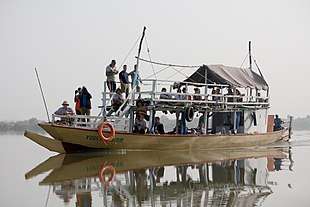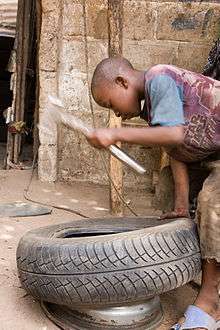Economy of the Gambia
The economy of the Gambia is heavily reliant on agriculture.[16] The Gambia has no important mineral or other natural resources, and has a limited agricultural base. About 75% of the population depends on crops and livestock for its livelihood. Small-scale manufacturing activity features the processing of peanuts, fish, and animal hides.
 Bird-watching tourists in the Gambia | |
| Currency | Dalasi (GMD, D) |
|---|---|
| 1 July – 30 June | |
Trade organisations | AU, AfCFTA, CEN-SAD, ECOWAS, WTO |
Country group |
|
| Statistics | |
| Population | |
| GDP | |
| GDP rank | |
GDP growth |
|
GDP per capita | |
GDP per capita rank | |
GDP by sector |
|
| 6.5% (2020 est.)[4] | |
Population below poverty line | |
| 35.9 medium (2015)[8] | |
Labour force | |
Labour force by occupation |
|
| Unemployment | 8.6% |
Average gross salary | $0.57 per man-hour (2009) |
Main industries | processing peanuts, fish, and hides; tourism; beverages; agricultural machinery assembly, woodworking, metalworking; clothing |
| External | |
| Exports | $132 million (f.o.b., 1998) |
Export goods | peanuts and peanut products, fish, cotton lint, palm kernels |
Main export partners | |
| Imports | $201 million (f.o.b., 1998) |
Import goods | foodstuffs, manufactures, fuel, machinery and transport equipment |
Main import partners | |
FDI stock | N/A (2011) |
Gross external debt | $430 million (1997 est.) |
| Public finances | |
| 120% of GDP (2017) | |
| Revenues | D3.8 billion (2009) |
| Expenses | $D733.6 million (2011) |
| Economic aid | $45.4 million (1995) |



Short-run economic progress remains highly dependent on foreign aid, and on responsible government economic management as forwarded by International Monetary Fund technical help and advice.
Economic history
Current GDP per capita of the Gambia registered a peak growth of 23.3% in the 1970s. Economic growth slowed by 8.30% in the 1980s and a further 5.20% in the 1990s.
Re-export trade normally constitutes a major segment of economic activity, but the 50% devaluation of the CFA franc in January 1994 made Senegalese goods more competitive and hurt the re-export trade. The Gambia has benefited from a rebound in tourism after its decline in response to the military's takeover in July 1994.
Macro-economic trend
This is a chart of trend of gross domestic product of Gambia at market prices estimated[17] by the International Monetary Fund with figures in millions of Dalasi (currency used in Gambia).
| Year | Gross Domestic Product | US dollar exchange | Inflation index (2000=100) |
|---|---|---|---|
| 1980 | 435 | 1.71 Dalasi | 13 |
| 1985 | 782 | 4.09 Dalasi | 25 |
| 1990 | 2,367 | 8.13 Dalasi | 65 |
| 1995 | 3,617 | 9.49 Dalasi | 90 |
| 2000 | 5,382 | 12.78 Dalasi | 100 |
| 2005 | 13,174 | 28.70 Dalasi | 158 |
For purchasing power parity comparisons, the US dollar is exchanged at 4.35 Dalasi only.
The Gambia's economy is characterized by traditional subsistence agriculture, a historic reliance on peanuts or groundnuts for export earnings, a re-export trade built up around its ocean port, low import duties, minimal administrative procedures, a fluctuating exchange rate with no exchange controls, and a significant tourism industry. Average wages in 2007 hover around $1–2 per day.
Economic sectors
Agriculture
Agriculture accounts for 23% of gross domestic product (GDP) and employs 75% of the labor force. Within agriculture, peanut production accounts for 5.3% of GDP, other crops 8.3%, livestock 4.4%, fishing 1.8%, and forestry 0.5%.
Industry
Industry accounts for 12% of GDP. Manufacturing accounts for 6% of GDP. The limited amount of manufacturing is primarily agriculturally based (e.g., peanut processing, bakeries, a brewery, and a tannery). Other manufacturing activities include soap, soft drinks, and clothing. Services account for 19% of GDP.
Tourism
Tourism in Gambia has three major strands. There is the traditional sun seeking holiday making use of the hot climate and wonderful beaches. The Gambia is also usually the first African destination for many European birders, in view of its easily accessed and spectacular avian fauna. There are also a significant number of African Americans tracing their roots in this country, from which so many Africans were taken during the slave trade.
The tourist season is the dry season, during the Northern Hemisphere winter.
Trade
In FY 1999, the UK and other EU countries were the Gambia's major domestic export markets, accounting for 86% of all exports. This was followed by Asia at 14% of exports, and the African at 8% of exports.
The U.K. and the other EU countries - namely, Germany, France, Netherlands, and Belgium - were the major source of imports, accounting for 60% of the total share of imports, followed by Asia at 23%, and African countries at 17%. The Gambia re-exports 11% of its exports going to and 14.6% of its imports coming from the United States.
Statistics
GDP:
- purchasing power parity $2.264 billion (2008 est.)
- real growth rate: 5.5% (2019 est.)[18]
- per capita: purchasing power parity - $1,300 (2008 est.)
- composition by sector:
- agriculture: 33%
- industry: 8.7%
- services: 58.3% (2008 est.)
Inflation rate (consumer prices): 6.5% (2019 est.)[19]
Labor force: 400,000
Labor force - by occupation: agriculture 75%, industry, commerce, and services 19%, government 6%
Budget:
- revenues: $88.6 million
- expenditures: $98.2 million, including capital expenditures of $ (Not Available) (FY96/97 est.)
Industries: processing peanuts, fish, and hides; tourism; beverages; agricultural machinery assembly, woodworking, metalworking; clothing
Electricity
- production: 75 GWh, entirely from fossil fuels (1998)
- consumption: 70 GWh (1998)
- Electricity is not imported or exported from the Gambia.
Agriculture - products: peanuts, pearl millet, sorghum, rice, maize, cassava (tapioca), palm kernels; cattle, sheep, goats; forest and fishery resources not fully exploited.
Exports: $132 million (f.o.b., 1998)
- commodities: peanuts and peanut products, fish, cotton lint, palm kernels.
- partners: Benelux 78%, Japan, United Kingdom, Hong Kong, France, Spain (1997)
Imports: $201 million (f.o.b., 1998)
- commodities: foodstuffs, manufactures, fuel, machinery and transport equipment.
- partners: Hong Kong, United Kingdom, Netherlands, Ivory Coast, France, Senegal, Belgium (1997)
Debt - external: $430 million (1997 est.)
Economic aid - recipient: $45.400 million (1995)
Currency: Dalasi (D)
Exchange rates: dalasi (D) per US$1 – 43.860 (January 2017), 11.626 (November 1999), 10.643 (1998), 10.200 (1997), 9.789 (1996), 9.546 (1995)
Fiscal year: 1 July - 30 June
See also
References
- "World Economic Outlook Database, April 2019". IMF.org. International Monetary Fund. Retrieved 29 September 2019.
- "World Bank Country and Lending Groups". datahelpdesk.worldbank.org. World Bank. Retrieved 29 September 2019.
- "Population, total - Gambia, The". data.worldbank.org. World Bank. Retrieved 16 February 2020.
- "World Economic Outlook Database, October 2019". IMF.org. International Monetary Fund. Retrieved 23 January 2020.
- "Global Economic Prospects, January 2020 : Slow Growth, Policy Challenges" (PDF). openknowledge.worldbank.org. World Bank. p. 147. Retrieved 22 January 2020.
- "Poverty headcount ratio at national poverty lines (% of population) - Gambia, The". data.worldbank.org. World Bank. Retrieved 16 February 2020.
- "Poverty headcount ratio at $1.90 a day (2011 PPP) (% of population) - Gambia, The". data.worldbank.org. World Bank. Retrieved 16 February 2020.
- "GINI index (World Bank estimate) - Gambia, The". data.worldbank.org. World Bank. Retrieved 16 February 2020.
- "Human Development Index (HDI)". hdr.undp.org. HDRO (Human Development Report Office) United Nations Development Programme. Retrieved 11 December 2019.
- "Inequality-adjusted Human Development Index (IHDI)". hdr.undp.org. HDRO (Human Development Report Office) United Nations Development Programme. Retrieved 11 December 2019.
- "Labor force, total - Gambia, The". data.worldbank.org. World Bank & ILO. Retrieved 16 February 2020.
- "Employment to population ratio, 15+, total (%) (national estimate) - Gambia, The". data.worldbank.org. World Bank & ILO. Retrieved 16 February 2020.
- "Ease of Doing Business in Gambia, The". Doingbusiness.org. Retrieved 2017-01-25.
- "Export Partners of the Gambia". CIA World Factbook. 2013. Retrieved 2015-05-11.
- "Import Partners of the Gambia". CIA World Factbook. 2013. Retrieved 2015-05-11.
- "The Gambia". Encyclopaedia Britannica. Retrieved 29 October 2019.
- International Monetary Fund
- "The Gambia and the IMF". IMF. Retrieved 2019-09-14.
- "Inflation, consumer prices (annual %) | Data". data.worldbank.org. Retrieved 2019-09-14.
Further reading
- Sternfeldt, Ann-Britt. (2000). The Good Tourist in the Gambia: Travelguide for Conscious Tourists. Translated from Swedish by Rolli Fölsch. TheGoodTourist. Sexdrega, Sweden. ISBN 91-974010-4-8.
